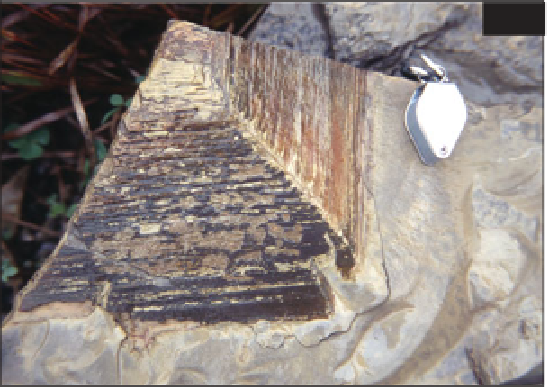Geoscience Reference
In-Depth Information
and regressions of the sea across an
intertidal-subtidal platform. The
sequence represents a range of
environments from brackish estuarine,
through shallow evaporitic and sabkha
settings, to near-normal marine lagoonal
and subtidal conditions. Two formations
are of especial importance for fossils: the
lower Fiddlers Green Formation and the
upper Williamsville Formation.
(67)
shows subdivisions of the Fiddlers Green
into a number of members, which
indicates that there is considerable
variation of environments, even within
the waterlime. Laminations suggest cyclic
sedimentation on a seasonal scale, and
there is strong evidence of algal
(stromatolite) structures. In some places,
algal mounds can be seen, and
eurypterids are common at these
locations. Also of great interest are the
giant salt pseudomorphs (
68
). Rock salt
(halite, NaCl) has a cubic crystal structure
and habit. Commonly, the former
presence of salt crystals can only be
inferred by pseudomorphs, where the
crystal has been dissolved by an influx of
water followed by deposition of sediment
into the mold where the crystal has been.
Many of the pseudomorphs show hopper-
faces, in which the normally flat faces of
the cubic crystal were hollow and bore
stairway-like stepped sides.
Environments evidenced by the rock
types include the following: (1) Supratidal
sabkha: a barren, hypersaline plain above
normal high tide mark but subject to
periodic flooding; examples of this
environment are the dolomitic shales of
the Camillus, Oatka and Scajaquada
formations. (2) Supratidal storm-gener-
ated breccias occur in the Ellicott Creek
Member of the Fiddlers Green Forma-
tion. (3) Hypersaline lakes and estuaries
are represented by massive gypsum beds.
(4) The intertidal environment is the one
in which the massive waterlimes of the
Fort Hill Formation and the Morganville
and Phelps members of the Fiddlers
Green Formation were deposited. Regular
exposure and evaporation led to the
development of large hopper salt crystals.
Algal mats and eurypterids are common,
but occasional ghosts of nautiloids and
gastropods suggest a much greater
diversity of organisms with calcareous
shells which are leached and so poorly
represented in the fossil biota. (5) The
subtidal environment preserved a greater
proportion of shelly faunas, such as the
68
68 Giant salt hopper
pseudomorph, Ellicott Creek
Member Fiddlers Green
Formation, floor of Neid Road
Quarry, Le Roy, New York.




Search WWH ::

Custom Search